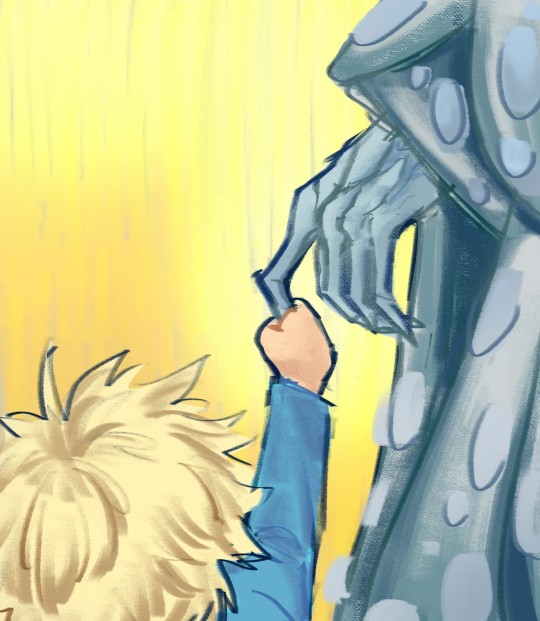#the silliest uncanny plant
Text
CW: A bit of body horror









#sketch#trigun#trigun stampede#knives millions#oc#dad!knives au#millions knives#vash the stampede#the silliest uncanny plant#thankyou for the motivation horror mlp
188 notes
·
View notes
Text
New story in Politics from Time: Democrats Needed the Virtual DNC to Connect With Viewers. Here’s What the Broadcast Got Right—and Wrong
It should’ve been the most boring half hour of the 2020 Democratic National Convention: a procedurally necessary roll call of 57 states and territories to confirm the foregone conclusion that Joe Biden would be the party’s nominee for President. Yet amid speeches from the candidate and his wife, Jill Biden; his history-making running mate, Kamala Harris; both Obamas; both Clintons; and leaders from across the ideological spectrum, including Republicans like Colin Powell and John Kasich, Tuesday’s roll call stole the show. Rhode Island went viral with a “calamari comeback” slogan and a platter of seafood. Washington Post humor columnist Alexandra Petri invented awards for her favorite delegations. And a Slate headline summed up the predominant response on left-leaning Twitter: “The DNC’s Roll Call Made Me Feel More Patriotic Than I Have in Years.”
Live TV can always be relied upon to provide a few laughs, whether intentional or accidental. Emotional responses are harder to elicit, particularly for speakers forced by the still-raging COVID-19 pandemic to address a bare-bones camera crew rather than a packed convention center. The roll call, in its sheer volume and variety, resonated so profoundly because it spoke to America’s most laudable values: diversity, resilience, aspiration. We heard from an Arizona teacher, a farmer in Kansas, students and recent grads whose futures have been put on hold. A Parkland father represented Florida, while a Nebraska meatpacking plant worker issued a wrenching plea: “Workers are dying from COVID, and a lot of us don’t have paid sick leave or even quality protective equipment. We are human beings, not robots, not disposable.” There were plenty of elected officials in the mix, too, but it was the regular people—of all races, genders, religions, sexual orientations—who made an indelible impression. They made us feel as though we were seeing each other, five months into a pandemic that has killed more than 170,000 Americans, and put face masks and six feet of social distance between responsible citizens and our neighbors.

DNCC via Getty Images—2020 DNCCKristin Urquiza, whose father, a Trump voter, died of coronavirus, addresses the virtual Democratic National Convention on August 17, 2020.
It’s not that the DNC failed to provide any moving speeches—though the fact that Barack and Michelle Obama, both of whom used the intimacy of the new format to make persuasive arguments about President Trump’s incompetence, remain the party’s most eloquent communicators won’t necessarily work in Biden and Harris’ favor. But political conventions have the same problem as elections themselves: especially in a country as polarized as ours, people whose decisions hinge on party platforms, candidates’ records and cogent analyses of current events are likely to go into them with their decision already made. To win over independents and propel ideologically aligned non-voters to the polls, a convention must appeal to emotion as well as reason. That means making people feel seen as well as united in a common cause—a tall order when isolation and suffering are the new normal, widespread unemployment has turned colleagues into competitors and many households’ reserves of hope are running on empty.
Standard political theater just doesn’t cut it in 2020, as Thursday’s anticlimactic litany of testimonials from insiders, in particular, confirmed. And that’s even before you factor in a sitting President with an uncanny ability to hijack a news cycle by sending a tweet. Let’s not forget that Trump built his political persona on reality TV, a medium that, for more than two decades now, has been training American viewers to value the outsize personalities of exhibitionists over the scripted and focus-grouped optics of polished professionals. He may be no great orator, but his colorful deficiencies can create the impression of candor. A competent, orderly, yet banal convention is no match for an endless supply of rude, bizarre, yet memorable antics.
So it matters that the DNC proved incapable of divesting from cliché. Putting Biden’s “build back better” slogan in the mouths of speaker after speaker mostly served to remind viewers that these telecasts were an exercise in coordinated messaging. A keynote montage of “rising stars” was edited to show them uttering faux-folksy phrases like “That’s a big effin’ deal” in unison. Bernie Sanders’ warning about authoritarianism made an effective lead-in to Michelle Obama’s gentler speech…until the feed cut away from Sanders and into the living room of an apparently unimpressed family that didn’t notice it was on the air. A video themed around feminism awkwardly pasted photos of Women’s March attendees into yellowed images of suffrage parades and addressed female voters with cloying second-person narration that recalled Virginia Slims’ condescending “You’ve come a long way, baby!” campaign. And in what was perhaps the silliest rhetorical gambit of the week, Kasich shot his speech at a literal intersection to illustrate that America was at a crossroads. At best, this level of hokeyness elicits a cringe. At worst, it telegraphs that the DNC and the candidates it represents don’t understand the urgency of the current moment.

DNCC via Getty Images—2020 DNCCIn this screenshot from the DNCC’s livestream of the 2020 Democratic National Convention, Republican, Former Ohio Governor John Kasich addresses the audience from a literal crossroads.
Americans who are hurting need to believe they’re being heard by those with the power to help alleviate their pain. That’s why the appeals of regular people, well spoken and otherwise, broke through so much politics-as-usual static. Along with the alternately funny, poignant and proud roll call, there was 11-year-old Estela Juarez, whose father is a Marine and whose mother was deported to Mexico in 2018. “Instead of protecting us,” she said, addressing the President, “you tore our world apart.” The words I couldn’t get out of my head this week came from Kristin Urquiza, who lost her Trump-voter father to coronavirus: “There are two Americas: the America that Donald Trump lives in and the America that my father died in.” If politicians care as deeply about families like the Juarezes and Urquizas as they claim to, then the only way to convey that concern to millions of voters trapped in quarantine nightmares of their own is to put aside the platitudes and hand over the microphone.
from Blogger https://ift.tt/2Yn60rB
via IFTTT
0 notes
Text
Documentary Initial Ideas - Ordinary objects, Unordinary stories.

Ján Švankmajer's Jabberwocky, (1971).
“...for me, the exotic is increasingly not on the surface but deep down: it is what we can achieve provided we put enough heart and will into finding it right here, on the spot, provided we notice a certain number of very rare prescious things that we did not pay attention to before... It's really André Breton who showed me that you can look without shame at stones, insects, leaves or flowers, with the same intense curiosity and from that contemplation you can draw emotions just as strong as those one feels looking at sculptures or paintings...Sometimes it is in the seemingly cheapest and most absurd, silliest and the most modest human activities in which a lock is found that enables access to the deepest and most general truths.” / Claude Lévi-Strauss
The themes for the documentary this semester are based around Home, Memory and Exile. All of these themes inspire me heavily, and it's been a fascination of mine to work around the concepts of childhood and home for many years now.
For the documentary I chose to focus on the relationship of memory and objects. I asked my mother what brings up her childhood, and early adulthood memories, while she lived in a communist Czechoslovakia. She told me that for her it is the smell of various products or foods, the taste of her mother's meals and cakes, and sounds too.
Every memory or story that she mentioned was always tied to an object that brought up her nostalgia and reminiscing. These included her mother's, my grandmother's metal hair curlers, smelly suncream that always reminded her that they could never travel and go for an exotic vacation during summer holidays, or food packaging that remined her of her mum and the smell that would spread through the house when she cooked. For example, when she hears or sees the metal hair curlers, she remembers the sound of bath and running water. They sometimes would run the water for other occasion than just to wash and curl their hair.
Sometimes when they wanted to have a conversation, not heard by the hearing devices, carefully planted in their walls due to the fact that my mother's brother emigrated, left Czechoslovakia, and they never expected to see him again. His emigration resulted in my grandmother loosing her job, and my mum was never being able to get into a respectable high school and later, university.
It fascinates me how such 'ordinary' objects can hold so many extraordinary stories. The stories come to life through these objects. I would love to explore the relationship between the object and its unrevealed story.



For the visual tone, I am very much influenced by Ján Švankmajer, a surrealist artist and filmmaker, who uses stop motion to bring every day objects to life. I think that his visual style and tone, of course, a little less uncanny, would be perfect for this documentary.

From Ján Švankmajer's The Death of Stalinism in Bohemia (1991).

From Ján Švankmajer's Jabberwocky, (1971).
Ján Švankmajer also believes that 'every-day' objects play a very important role in our lifes, art making, and especially, telling stories. He says:
“Objects hide within themselves the stories they have been witness to...people touch objects, things in certain life situations, during various moods and moments of tension, and they transfer their moods and emotions to them with their touches...to illustrate their narrative...therein lay the power of animation...to have the object speak for themselves. In this way a meaningful relationship arises between people and things.”
1 note
·
View note
Link
It should’ve been the most boring half hour of the 2020 Democratic National Convention: a procedurally necessary roll call of 57 states and territories to confirm the foregone conclusion that Joe Biden would be the party’s nominee for President. Yet amid speeches from the candidate and his wife, Jill Biden; his history-making running mate, Kamala Harris; both Obamas; both Clintons; and leaders from across the ideological spectrum, including Republicans like Colin Powell and John Kasich, Tuesday’s roll call stole the show. Rhode Island went viral with a “calamari comeback” slogan and a platter of seafood. Washington Post humor columnist Alexandra Petri invented awards for her favorite delegations. And a Slate headline summed up the predominant response on left-leaning Twitter: “The DNC’s Roll Call Made Me Feel More Patriotic Than I Have in Years.”
Live TV can always be relied upon to provide a few laughs, whether intentional or accidental. Emotional responses are harder to elicit, particularly for speakers forced by the still-raging COVID-19 pandemic to address a bare-bones camera crew rather than a packed convention center. The roll call, in its sheer volume and variety, resonated so profoundly because it spoke to America’s most laudable values: diversity, resilience, aspiration. We heard from an Arizona teacher, a farmer in Kansas, students and recent grads whose futures have been put on hold. A Parkland father represented Florida, while a Nebraska meatpacking plant worker issued a wrenching plea: “Workers are dying from COVID, and a lot of us don’t have paid sick leave or even quality protective equipment. We are human beings, not robots, not disposable.” There were plenty of elected officials in the mix, too, but it was the regular people—of all races, genders, religions, sexual orientations—who made an indelible impression. They made us feel as though we were seeing each other, five months into a pandemic that has killed more than 170,000 Americans, and put face masks and six feet of social distance between responsible citizens and our neighbors.

DNCC via Getty Images—2020 DNCCKristin Urquiza, whose father, a Trump voter, died of coronavirus, addresses the virtual Democratic National Convention on August 17, 2020.
It’s not that the DNC failed to provide any moving speeches—though the fact that Barack and Michelle Obama, both of whom used the intimacy of the new format to make persuasive arguments about President Trump’s incompetence, remain the party’s most eloquent communicators won’t necessarily work in Biden and Harris’ favor. But political conventions have the same problem as elections themselves: especially in a country as polarized as ours, people whose decisions hinge on party platforms, candidates’ records and cogent analyses of current events are likely to go into them with their decision already made. To win over independents and propel ideologically aligned non-voters to the polls, a convention must appeal to emotion as well as reason. That means making people feel seen as well as united in a common cause—a tall order when isolation and suffering are the new normal, widespread unemployment has turned colleagues into competitors and many households’ reserves of hope are running on empty.
Standard political theater just doesn’t cut it in 2020, as Thursday’s anticlimactic litany of testimonials from insiders, in particular, confirmed. And that’s even before you factor in a sitting President with an uncanny ability to hijack a news cycle by sending a tweet. Let’s not forget that Trump built his political persona on reality TV, a medium that, for more than two decades now, has been training American viewers to value the outsize personalities of exhibitionists over the scripted and focus-grouped optics of polished professionals. He may be no great orator, but his colorful deficiencies can create the impression of candor. A competent, orderly, yet banal convention is no match for an endless supply of rude, bizarre, yet memorable antics.
So it matters that the DNC proved incapable of divesting from cliché. Putting Biden’s “build back better” slogan in the mouths of speaker after speaker mostly served to remind viewers that these telecasts were an exercise in coordinated messaging. A keynote montage of “rising stars” was edited to show them uttering faux-folksy phrases like “That’s a big effin’ deal” in unison. Bernie Sanders’ warning about authoritarianism made an effective lead-in to Michelle Obama’s gentler speech…until the feed cut away from Sanders and into the living room of an apparently unimpressed family that didn’t notice it was on the air. A video themed around feminism awkwardly pasted photos of Women’s March attendees into yellowed images of suffrage parades and addressed female voters with cloying second-person narration that recalled Virginia Slims’ condescending “You’ve come a long way, baby!” campaign. And in what was perhaps the silliest rhetorical gambit of the week, Kasich shot his speech at a literal intersection to illustrate that America was at a crossroads. At best, this level of hokeyness elicits a cringe. At worst, it telegraphs that the DNC and the candidates it represents don’t understand the urgency of the current moment.

DNCC via Getty Images—2020 DNCCIn this screenshot from the DNCC’s livestream of the 2020 Democratic National Convention, Republican, Former Ohio Governor John Kasich addresses the audience from a literal crossroads.
Americans who are hurting need to believe they’re being heard by those with the power to help alleviate their pain. That’s why the appeals of regular people, well spoken and otherwise, broke through so much politics-as-usual static. Along with the alternately funny, poignant and proud roll call, there was 11-year-old Estela Juarez, whose father is a Marine and whose mother was deported to Mexico in 2018. “Instead of protecting us,” she said, addressing the President, “you tore our world apart.” The words I couldn’t get out of my head this week came from Kristin Urquiza, who lost her Trump-voter father to coronavirus: “There are two Americas: the America that Donald Trump lives in and the America that my father died in.” If politicians care as deeply about families like the Juarezes and Urquizas as they claim to, then the only way to convey that concern to millions of voters trapped in quarantine nightmares of their own is to put aside the platitudes and hand over the microphone.
0 notes
Link
It should’ve been the most boring half hour of the 2020 Democratic National Convention: a procedurally necessary roll call of 57 states and territories to confirm the foregone conclusion that Joe Biden would be the party’s nominee for President. Yet amid speeches from the candidate and his wife, Jill Biden; his history-making running mate, Kamala Harris; both Obamas; both Clintons; and leaders from across the ideological spectrum, including Republicans like Colin Powell and John Kasich, Tuesday’s roll call stole the show. Rhode Island went viral with a “calamari comeback” slogan and a platter of seafood. Washington Post humor columnist Alexandra Petri invented awards for her favorite delegations. And a Slate headline summed up the predominant response on left-leaning Twitter: “The DNC’s Roll Call Made Me Feel More Patriotic Than I Have in Years.”
Live TV can always be relied upon to provide a few laughs, whether intentional or accidental. Emotional responses are harder to elicit, particularly for speakers forced by the still-raging COVID-19 pandemic to address a bare-bones camera crew rather than a packed convention center. The roll call, in its sheer volume and variety, resonated so profoundly because it spoke to America’s most laudable values: diversity, resilience, aspiration. We heard from an Arizona teacher, a farmer in Kansas, students and recent grads whose futures have been put on hold. A Parkland father represented Florida, while a Nebraska meatpacking plant worker issued a wrenching plea: “Workers are dying from COVID, and a lot of us don’t have paid sick leave or even quality protective equipment. We are human beings, not robots, not disposable.” There were plenty of elected officials in the mix, too, but it was the regular people—of all races, genders, religions, sexual orientations—who made an indelible impression. They made us feel as though we were seeing each other, five months into a pandemic that has killed more than 170,000 Americans, and put face masks and six feet of social distance between responsible citizens and our neighbors.

DNCC via Getty Images—2020 DNCCKristin Urquiza, whose father, a Trump voter, died of coronavirus, addresses the virtual Democratic National Convention on August 17, 2020.
It’s not that the DNC failed to provide any moving speeches—though the fact that Barack and Michelle Obama, both of whom used the intimacy of the new format to make persuasive arguments about President Trump’s incompetence, remain the party’s most eloquent communicators won’t necessarily work in Biden and Harris’ favor. But political conventions have the same problem as elections themselves: especially in a country as polarized as ours, people whose decisions hinge on party platforms, candidates’ records and cogent analyses of current events are likely to go into them with their decision already made. To win over independents and propel ideologically aligned non-voters to the polls, a convention must appeal to emotion as well as reason. That means making people feel seen as well as united in a common cause—a tall order when isolation and suffering are the new normal, widespread unemployment has turned colleagues into competitors and many households’ reserves of hope are running on empty.
Standard political theater just doesn’t cut it in 2020, as Thursday’s anticlimactic litany of testimonials from insiders, in particular, confirmed. And that’s even before you factor in a sitting President with an uncanny ability to hijack a news cycle by sending a tweet. Let’s not forget that Trump built his political persona on reality TV, a medium that, for more than two decades now, has been training American viewers to value the outsize personalities of exhibitionists over the scripted and focus-grouped optics of polished professionals. He may be no great orator, but his colorful deficiencies can create the impression of candor. A competent, orderly, yet banal convention is no match for an endless supply of rude, bizarre, yet memorable antics.
So it matters that the DNC proved incapable of divesting from cliché. Putting Biden’s “build back better” slogan in the mouths of speaker after speaker mostly served to remind viewers that these telecasts were an exercise in coordinated messaging. A keynote montage of “rising stars” was edited to show them uttering faux-folksy phrases like “That’s a big effin’ deal” in unison. Bernie Sanders’ warning about authoritarianism made an effective lead-in to Michelle Obama’s gentler speech…until the feed cut away from Sanders and into the living room of an apparently unimpressed family that didn’t notice it was on the air. A video themed around feminism awkwardly pasted photos of Women’s March attendees into yellowed images of suffrage parades and addressed female voters with cloying second-person narration that recalled Virginia Slims’ condescending “You’ve come a long way, baby!” campaign. And in what was perhaps the silliest rhetorical gambit of the week, Kasich shot his speech at a literal intersection to illustrate that America was at a crossroads. At best, this level of hokeyness elicits a cringe. At worst, it telegraphs that the DNC and the candidates it represents don’t understand the urgency of the current moment.

DNCC via Getty Images—2020 DNCCIn this screenshot from the DNCC’s livestream of the 2020 Democratic National Convention, Republican, Former Ohio Governor John Kasich addresses the audience from a literal crossroads.
Americans who are hurting need to believe they’re being heard by those with the power to help alleviate their pain. That’s why the appeals of regular people, well spoken and otherwise, broke through so much politics-as-usual static. Along with the alternately funny, poignant and proud roll call, there was 11-year-old Estela Juarez, whose father is a Marine and whose mother was deported to Mexico in 2018. “Instead of protecting us,” she said, addressing the President, “you tore our world apart.” The words I couldn’t get out of my head this week came from Kristin Urquiza, who lost her Trump-voter father to coronavirus: “There are two Americas: the America that Donald Trump lives in and the America that my father died in.” If politicians care as deeply about families like the Juarezes and Urquizas as they claim to, then the only way to convey that concern to millions of voters trapped in quarantine nightmares of their own is to put aside the platitudes and hand over the microphone.
0 notes